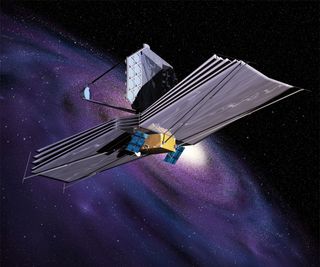James Webb Space Telescope Assembly Practice Runs Start

Faced with the complicated job of putting together the $8.8 billion James Webb Space Telescope, NASA and lead contractor Northrop Grumman are starting to run practice assembly tests using a "pathfinder" telescope.
The technique was used during the construction of NASA's Chandra X-Ray Observatory, which launched in 1999, and was apparently quite successful because the telescope remains scientifically productive today, said Jon Arenberg, James Webb Space Telescope (JWST) chief engineer at Northrop Grumman.
"It helps us do a number of things, obviously — how to handle such a large structure, how to attach the mirrors," Arenberg told Space.com. "So this allows us to wring out a 140,000-lb. [63,500 kilograms] stand and robot assembly process." [Photos: Building the James Webb Space Telescope]
"This is an example of practice makes perfect, so we practice, practice, practice so when we get the flight hardware, it goes off as smoothly as possible," he added.
The pathfinder's design is fairly similar to that of the actual JWST, but there are some differences, Arenberg said. For example, the pathfinder lacks two winglike parts on either side of a backplane that holds a large part of the telescope together.

Hardware tests
JWST is the highly anticipated successor to NASA's iconic Hubble Space Telescope. When it's up and running, the infrared-optimized JWST will probe the atmospheres of exoplanets, study the universe's first galaxies and investigate how stars and planets form, among other things, NASA officials say.
Get the Space.com Newsletter
Breaking space news, the latest updates on rocket launches, skywatching events and more!
But the telescope has received criticism for cost and development overruns. Around the turn of the century, JWST was projected to cost up to $3.5 billion and launch no later than 2011, according to a U.S. Government Accountability Office report released in 2014.
The coming months will be crucial to the success of JWST, as components are starting to be completed and shipped for testing and assembly.
One major sign of success came in July, when load testing was finished on the observatory's primary mirror backplane support structure, the device that holds the telescope's mirror segments and science instruments. The backplane support was scheduled to be shipped to NASA's Goddard Space Flight Center in Maryland at the end of 2014 to be placed in its clean room and begin receiving mirrors.
"Completion of the testing and formal delivery of the backplane, to us, is a huge step," Arenberg said, adding that other components are getting close to that stage.
There have also been some other milestones: Mirrors have already been sent to Goddard, telescope electronics that operate the motors are on their way and the flight sunshield layers are being manufactured, with the second one (out of a total of five) already built.
Moving toward assembly
In the next year or so, the big pieces of the telescope will begin assembly to be ready for system testing, which will take up about two of the four years between now and JWST's planned 2018 launch.

Another major step will come when the telescope is mated with its main instrument module as well as the optics, which themselves will need to be tested at NASA's Johnson Space Center in Houston to ensure the hardware meets design specifications.
As each component is finished, it is generally flown to Goddard in a huge military transport plane, the Lockheed C-5 Galaxy, and is shipped to and from the airport in environmentally controlled containers pulled by a semi-trailer.
The last big trip will take JWST to the South American nation of French Guiana, where the launch will take place aboard an Ariane 5 rocket. (The telescope will first be shipped to Los Angeles, and then placed on a boat to go through the Panama Canal.)
Major subcontractors on JWST include Ball Aerospace & Technologies (optical design and mirrors, among other things); ITT Exelis (integrating and testing the optical telescope); ATK (telescope's composite structure); and NeXolve Corp. (sunshield layers).
Follow Elizabeth Howell @howellspace, or Space.com @Spacedotcom. We're also on Facebook and Google+. Original article on Space.com.
Join our Space Forums to keep talking space on the latest missions, night sky and more! And if you have a news tip, correction or comment, let us know at: community@space.com.

Elizabeth Howell (she/her), Ph.D., is a staff writer in the spaceflight channel since 2022 covering diversity, education and gaming as well. She was contributing writer for Space.com for 10 years before joining full-time. Elizabeth's reporting includes multiple exclusives with the White House and Office of the Vice-President of the United States, an exclusive conversation with aspiring space tourist (and NSYNC bassist) Lance Bass, speaking several times with the International Space Station, witnessing five human spaceflight launches on two continents, flying parabolic, working inside a spacesuit, and participating in a simulated Mars mission. Her latest book, "Why Am I Taller?", is co-written with astronaut Dave Williams. Elizabeth holds a Ph.D. and M.Sc. in Space Studies from the University of North Dakota, a Bachelor of Journalism from Canada's Carleton University and a Bachelor of History from Canada's Athabasca University. Elizabeth is also a post-secondary instructor in communications and science at several institutions since 2015; her experience includes developing and teaching an astronomy course at Canada's Algonquin College (with Indigenous content as well) to more than 1,000 students since 2020. Elizabeth first got interested in space after watching the movie Apollo 13 in 1996, and still wants to be an astronaut someday. Mastodon: https://qoto.org/@howellspace